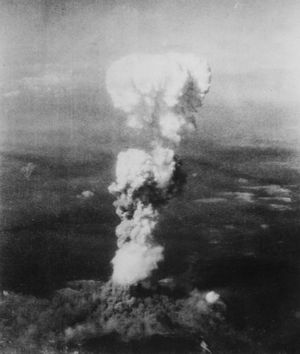With any event in history it is impossible to 100% accurately predict a what if situation. Such is the case is the dropping of the atomic bomb on Hiroshima and Nagasaki in 1945. It is impossible to say with absolute certainty one way or the other in the debate of whether the atomic bomb should have been dropped, or whether the Japanese would have surrendered without its use. However, it is possible to make assumptions on the matter based on the facts of the war. This paper intends to present the facts of the war, and come to a conclusion in the still controversial debate over the bombing of Hiroshima and Nagasaki.
The United States was brought into the Pacific War in 1941 with the Japanese bombing of Pearl Harbor, Hawaii. However, the Japanese had been at war with China since 1937, was stretching its territorial holdings further into the country, and looking to Southeast Asia for further advancement. One reason for these ambitious goals was to build a state that would support Japan’s need for resources without importing them from Western nations such as the U.S; and since the U.S opposed the war in China and Japan’s further advancement into China and Southeast Asia, the U.S had found ways around political blockades to place embargos on resources to Japan. These various resource embargos; including oil, petroleum, and metals, and aviation fuel, left Japan strapped for war materials. Without Southeast Asian resources to bridge the gap, all that Japan had bleed and died for would have been lost. For this reason, and the irreconcilable differences in political ideology, lack of amiable negotiation agreements, and a feeling of being stifled by the West, Japan felt they had no choice but to bring the U.S into the war.
Early battle went well for the Japanese, as evidenced by the results of the Pearl Harbor attack. Japan was also able to go on and take territories in Southeast Asia including Burma, Thailand, and Singapore. However, their advancement and good news would soon come to an end. When the U.S took Manila, they succeeded in cutting off the Japanese from Southeast Asia, and thus their resources. The notorious kamikaze pilots came from this era of desperation when the Japanese still refused to back down, but saw the plight of their situation. They were extremely low on resources, morale began to plummet, and the U.S was right on their doorsteps. Mass U.S bombings tore apart cities across Japan, from Tokyo to Osaka, Nagoya, and Kobe; communications were shot, huge portions of industrial sectors destroyed, and transportation mechanisms devastated[1]. This is not even mentioning the devastation that civilians in these cities experienced, which was one reason for the plummeting morale and increasing desperation for an end to the violence. Thousands were killed, thousands more forced to leave their homes and seek refuge in nearby farm villages or monasteries. Despite this, and a lack of morale, most Japanese remained loyal and ready to serve their country, and patriotic organizations saw to it that those who didn’t were reprimanded and/or imprisoned.
After American forces landed at Okinawa there was little more resistance. Statesmen, realizing the seriousness of Japan’s wartime situation, began organizing efforts for peace. However, the very stubborn and proud military refused to give in. Military officials noted that they would rather “fight to the bitter end than to agree to any surrender that might, from its viewpoint, threaten Japan’s future integrity or jeopardize the continued existence of the imperial institution.”[2]
In 1945, advocates for peace persuaded the emperor to appoint Suzuki Kantaro to Prime Minister as a successor to the previous Koiso. Kantaro’s appointment was a plea for peace as Kantaro was used as the figurehead of the peace cabinet. Mid 1945 saw Suzuki’s initiation of peace. A letter was drafted to the Russian government asking that they mediate end-war terms between the U.S and Japan. However, the letter was to be in vain, as the U.S, England, and Russia were already holding talks among themselves, and were pessimistic of Japanese peacemaking intentions. This can partially be attributed to the political instability that was the Japanese conflict between the military and the statesmen, and partially due to President Truman’s lack of desire to show mercy to the Japanese. At this point the Atomic Bomb had already been developed and tested, and Truman knew militarily there was no way the U.S would lose the war. Pride ran deep on both sides of barbed wire fence. The Japanese military refused to give up what they’d won thus far in battle, and the U.S refused to end the war and let them keep it. The U.S wanted an unconditional surrender, period. The Potsdam Declaration, a set of terms drafted in Germany by the U.S, England, and Russia, was proposed to the Japanese and was evidence that the U.S was now unwilling to except any negotiations.
Japan was torn. Suzuki feared the American government and the threats of mass destruction should the Potsdam Declaration be denied. Statesman looked to peace by refused to yield their territories to the U.S. Moreover, the military refused to back down and make meaningless all the lives lost in the war. Those lives were important memorials of the suffering that Japan had to endure in order to gain the spoils they now possessed. Already, the U.S had cut off some of those spoils, and unconditional surrender only meant dishonor to their country and the men who died for it.
On the American side, Truman concerned himself with a quick end to the war. Later other reasons would be cited, such as an end to a war that was claiming far too many American lives. However, it is commonly noted that Truman had the A-bomb and was merely all too ready to use it. Truman is quoted as saying, “I regarded the bomb as a military weapon and never had any doubt that it should be used.”[3] Further more, Truman wrote in his diary on July 25, 1945, “This weapon is to be used against Japan between now and August 10th. I have told the Sec. of War, Mr. Stimson, to use it so that military objectives and soldiers and sailors are the target and not women and children. Even if the Japs are savages, ruthless, merciless and fanatic, we as the leader of the world for the common welfare cannot drop that terrible bomb on the old capital or the new. He and I are in accord. The target will be a purely military one and we will issue a warning statement asking the Japs to surrender and save lives.”[4]
It is unfortunate to note that although Truman wrote and spoke of saving lives, both American and Japanese, he completely devastated two cities for generations to come killing women, children, and men indiscriminately. After the bombing of Hiroshima, Truman dropped leaflets on Japanese cities detailing the destruction, and asking that the Japanese people urge their government to surrender unconditionally.[5] As history goes, this was all to no avail. Nagasaki was next. Despite this destruction, and the announcement that Russia would be joining the war, the Japanese military still held to its notion that unconditional surrender was not an option; and that utter and devastating defeat would be better than dishonorable surrender. Suzuki was in a tough position. He urged for peace and plead with the emperor to order the military to stand down. On August 14, 1945 the emperor finally heeded pleas for peace and issued an official end to the war.
It was a long, hard, and stubborn battle, but was the atomic bomb truly the answer? This paper has come to the conclusion that it was not. The Japanese were devastated before the A-bombs were ever dropped. Despite maintained military resistance, the Japanese were on a downward spiral. U.S bombings were devastating cities across Japan, and the U.S were already making their way into the country. Keeping all this in mind, it can only be noted that it was a matter of time before Japanese defeat would have occurred. Sure, it would have taken more time, and claimed more lives. However, weighing this, and the destruction caused by the atom bomb then and for decades for follow, one can only reach the conclusion that prolonged fighting would have been better, and would have reached the same end without the destruction and devastation of the mushroom cloud. It seems in this situation, Truman was far too eager to use his prized weapon, and that lives were not the first thing on this mind. The results of his actions would suggest an alternative to this line of thinking.
While the debate still rages on, it seems clear to the author of this paper that the dropping of the atom bomb was not the only way to end the war and force the stubborn Japanese army into submission.
Bibliography
Harry S. Truman Library, Miscellaneous historical document file, no. 258
James L. McClain, A Modern History: Japan, (W.W Norton & Company, Inc, 2002), 506.
Public Papers of the Presidents of the United States: Harry S. Truman, Containing the
Public Messages, Speeches and Statements of the President April 12 to December 31, 1945 (Washington D.C.: United States Government Printing Office, 1961) page 212
Robert H. Ferrell, Off the Record: The Private Papers of Harry S. Truman (New York:
Harper and Row, 1980) pp. 55-56
[1] James L. McClain, A Modern History: Japan, (W.W Norton & Company, Inc, 2002), 506.
[2] McClain, 510
[3] McClain, 513
[4] Robert H. Ferrell, Off the Record: The Private Papers of Harry S. Truman (New York: Harper and Row, 1980) pp. 55-56
[5] Harry S. Truman Library, Miscellaneous historical document file, no. 258


